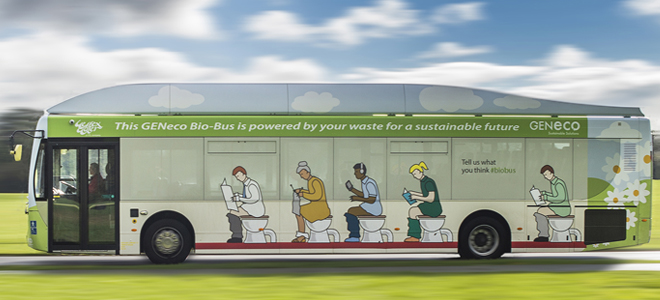A bus powered by biomethane gas which is generated from food and human waste is scheduled to enter into regular service on Wednesday, March 25, 2015 in Avonmouth, Bristol in the United Kingdom.
Here is how the Bio-Bus — operated by First West of England on the Service 2 (Get it? Number 2?!?) route from Cribbs Causeway, through the city centre to Stockwood four days per week with 32,674 households along the way helping indirectly to fuel it — works, according to this document:
- Every year, GENeco treats 75 million cubic meters of sewage waste and 35,000 tons of inedible food waste in Bristol.
- This waste gets digested for 12 to 18 days by special bacteria, producing methane-rich biogas.
- The gas is then cleaned to remove carbon dioxide and impurities, upgraded and checked for quality.
- The dome-like tanks on the roof of the vehicle are then filled with the gas that powers the Bio-Bus.
- The bus can travel approximately 300 kilometers on a tank of gas; and the engine itself is similar to that found in a normal diesel bus.
Here are some interesting facts pertaining to the Bio-Bus from the same document:
- It emits as much as 30 percent less carbon dioxide than a standard diesel bus.
- The emissions produced are virtually free of odor, believe it or not.
- The average number of people on a bus is 32 compared to 1.58 in a car.
- Your annual food and sewage waste could power a whole return trip on Service 2.
- There are approximately 46,500 passenger journeys during an average week on Service 2.
- The annual waste from people living near Service 2 could power the Bio-Bus for 2.5 million miles.
Some odoriferously flatulent passengers aboard airplanes can take a note or two from the Bio-Bus, apparently…
…which leads me to my next thought: imagine if food and human waste could contribute to powering an airplane one day. Costs could be significantly reduced for airlines — and perhaps passed down to paying passengers; although with the recent actions from airlines which include not reducing fuel surcharges despite the price of crude oil being significantly lower, I know that is wishful thinking.
I can see the flight attendants now, encouraging passengers to use the lavatories as much as possible, feeding them meals of beans and other foods known to naturally generate gas in the human body; and if there is any leftover food — not a problem.
Lavatories? Forget that. Knowing management of the airlines, they will most likely dismantle lavatories aboard airplanes and replace them with more seats — each equipped with a toilet function — in which to cram passengers. Hey — no more of that strange blue liquid; but then again, possibly no more opportunities to join the “mile-high club” either…
…that is, unless you purchase this furniture.
Then again, with the implementation of a toilet motorcycle by TOTO — a company which manufactures toilets in Japan — I suppose anything is possible:
https://youtu.be/C4IJix0tUi8
Due to the typical diet of many people, human waste — unlike horse and cow manure — is not considered an ideal substance for introducing nutrition to plants; so it is typically flushed from toilets as untreated sewage; wends its way into waterways such as lakes, rivers and oceans; and ultimately contributes towards a major public health crisis which purportedly kills an estimated 1.4 million children each year, according to the World Health Organization and this article written by Stephanie Pappas of LiveScience.
Have you ever had an idea that you thought had potential — but either did not know how to implement it or wondered if it was even possible to bring to reality? For many years — disregarding physics and chemistry temporarily while nurturing my imagination — I had thought about cars being powered by human waste and trash of which we would normally dispose. Think about it: no need to stop on a long car trip for a toilet break or to refuel the car, which saves time and money. Fewer fuel stations mean more land to use. The process would be environmentally friendly, as there would be less of a need for landfills and the oceans would be cleaner…
…but some people laughed at me and my idea, thinking it was ludicrous and disgusting.
Well, who is laughing now?!? Certainly not me, as I get no benefit or compensation for the implementation of this idea…
…but I do applaud it. I have always thought that there were ways of taking materials of which we normally regard as waste and repurpose them to our benefit — saving time, money and the environment.
The Bio-Bus will be operating in Bristol starting on Wednesday, March 25, 2015 on selected journeys on Service 2; and if you would like to be a passenger on this bus, please consult the timetable which is included in this document which you may download.
If this Bio-Bus turns out to be successful, a fleet of them may be introduced into service.
Image courtesy of GENeco.
